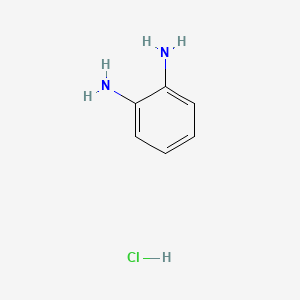
Benzene-o-diamine monohydrochloride
Overview
Description
Benzene-o-diamine monohydrochloride is a useful research compound. Its molecular formula is C6H9ClN2 and its molecular weight is 144.60 g/mol. The purity is usually 95%.
BenchChem offers high-quality this compound suitable for many research applications. Different packaging options are available to accommodate customers' requirements. Please inquire for more information about this compound including the price, delivery time, and more detailed information at [email protected].
Scientific Research Applications
Common Synthetic Routes
- Hydrochlorination of o-Phenylenediamine : This method involves treating o-phenylenediamine with hydrochloric acid to yield the monohydrochloride salt.
- Condensation Reactions : Benzene-o-diamine can react with various aldehydes and ketones to form valuable organic compounds such as benzimidazoles, which are important in medicinal chemistry.
Organic Synthesis
Benzene-o-diamine monohydrochloride serves as a versatile building block in organic synthesis. It participates in various condensation reactions leading to the formation of complex molecules.
- Benzimidazole Derivatives : It condenses with carboxylic acids to produce benzimidazole derivatives, which have applications in drug development and agrochemicals .
| Reaction Type | Product | Application |
|---|---|---|
| Condensation with carboxylic acids | Benzimidazoles | Pharmaceuticals |
| Reaction with aldehydes | 2-substituted benzimidazoles | Anticancer agents |
Pharmaceutical Applications
This compound is crucial in the pharmaceutical industry for synthesizing various drugs. Its derivatives exhibit a range of biological activities including:
- Anticancer Properties : Compounds derived from benzene-o-diamine have shown potential in inhibiting cancer cell proliferation .
- Antimicrobial Activity : Certain derivatives demonstrate significant antimicrobial effects against bacteria and fungi, making them candidates for developing new antibiotics.
Dye Manufacturing
The compound is also utilized in the dye industry due to its ability to form colored complexes with metals. It is particularly effective in producing azo dyes, which are widely used in textiles.
Case Study 1: Anticancer Activity
A study evaluated the anticancer properties of benzene-o-diamine derivatives against various cancer cell lines. The results indicated that specific derivatives inhibited cell growth significantly:
- Cell Lines Tested : A549 (lung adenocarcinoma), C6 (rat glioma).
- Inhibition Rates : Some derivatives achieved over 70% inhibition at specific concentrations.
Case Study 2: Antimicrobial Efficacy
Research focused on the incorporation of benzene-o-diamine derivatives into polymer matrices for dental applications showed promising results:
- Microbial Strains Tested : Candida albicans.
- Concentration Levels : Formulations containing 3% and 5% of the compound led to a reduction of fungal colonies by up to 3 log units compared to control groups.
Properties
CAS No. |
39145-59-0 |
|---|---|
Molecular Formula |
C6H9ClN2 |
Molecular Weight |
144.60 g/mol |
IUPAC Name |
benzene-1,2-diamine;hydrochloride |
InChI |
InChI=1S/C6H8N2.ClH/c7-5-3-1-2-4-6(5)8;/h1-4H,7-8H2;1H |
InChI Key |
GNNALEGJVYVIIH-UHFFFAOYSA-N |
Canonical SMILES |
C1=CC=C(C(=C1)N)N.Cl |
Origin of Product |
United States |
Synthesis routes and methods
Procedure details












Disclaimer and Information on In-Vitro Research Products
Please be aware that all articles and product information presented on BenchChem are intended solely for informational purposes. The products available for purchase on BenchChem are specifically designed for in-vitro studies, which are conducted outside of living organisms. In-vitro studies, derived from the Latin term "in glass," involve experiments performed in controlled laboratory settings using cells or tissues. It is important to note that these products are not categorized as medicines or drugs, and they have not received approval from the FDA for the prevention, treatment, or cure of any medical condition, ailment, or disease. We must emphasize that any form of bodily introduction of these products into humans or animals is strictly prohibited by law. It is essential to adhere to these guidelines to ensure compliance with legal and ethical standards in research and experimentation.













